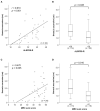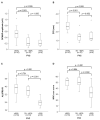Thoracic Excursion Is a Biomarker for Evaluating Respiratory Function in Amyotrophic Lateral Sclerosis
- PMID: 35401409
- PMCID: PMC8984343
- DOI: 10.3389/fneur.2022.853469
Thoracic Excursion Is a Biomarker for Evaluating Respiratory Function in Amyotrophic Lateral Sclerosis
Abstract
Objective: To evaluate the usefulness of thoracic excursion as a biomarker in patients with amyotrophic lateral sclerosis (ALS).
Methods: We measured the forced the vital capacity (FVC), thoracic excursion, baseline-to-peak diaphragmatic compound muscle action potential (DCMAP) amplitude, diaphragm thickness at full inspiration (DTfi), Medical Research Council (MRC) sum score for muscle strength, and arterial partial pressures of oxygen and carbon dioxide and administered the Amyotrophic Lateral Sclerosis Functional Rating Scale-Revised (ALSFRS-R) and modified Medical Research Council (mMRC) Dyspnea Scale. The test-retest reliability of thoracic excursion was determined.
Results and conclusions: Thirty-four patients with ALS and 26 age- and sex-matched healthy participants were enrolled. Thoracic excursion measurement had excellent test-retest reliability (intraclass coefficient: 0.974). Thoracic excursion was more strongly correlated with FVC (r = 0.678, p < 0.001) than DCMAP amplitude (r = 0.501, p = 0.003) and DTfi (r = 0.597, p < 0.001). It was also correlated with ALSFRS-R score (r = 0.610, p < 0.001), MRC sum score (r = 0.470, p = 0.005), and mMRC Dyspnea Scale score (r = -0.446, p = 0.008) and was the most sensitive parameter for assessing dyspnea and FVC. Thoracic excursion decreased as FVC declined in the early and late stages, there were no differences in DCMAP amplitude and DTfi between the early and late stages, and ALSFRS-R score and MRC sum score decreased only in the late stage. Thoracic excursion was well correlated with respiratory function and is useful for predicting respiratory and general dysfunction in patients with ALS regardless of stage.
Keywords: amyotrophic lateral sclerosis; biomarker; pulmonary function test; respiratory function; thoracic excursion.
Copyright © 2022 Iguchi, Mano, Iwasa, Ozaki, Yamada, Kikutsuji, Kido and Sugie.
Conflict of interest statement
The authors declare that the research was conducted in the absence of any commercial or financial relationships that could be construed as a potential conflict of interest.
Figures






References
-
- Prell T, Ringer TM, Wullenkord K, Garrison P, Gunkel A, Stubendorff B, et al. . Assessment of pulmonary function in amyotrophic lateral sclerosis: when can polygraphy help evaluate the need for non-invasive ventilation? J Neurol Neurosurg Psychiatry. (2016) 87:1022–6. 10.1136/jnnp-2015-312185 - DOI - PMC - PubMed
LinkOut - more resources
Full Text Sources
Miscellaneous

